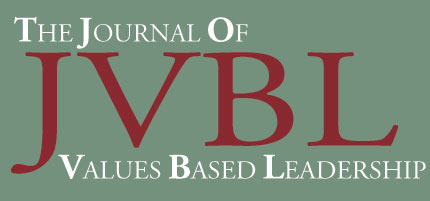- CONTENTS:
- Table of ContentsLetter from the EditorSustainability and the Bottom Line: The Responsible Collusion of Economics, Social Responsibility, and the EnvironmentProgress Toward Zero: The Climb to SustainabilityPlant Tour and Meeting with Members of Interface's Sustainability Team: December 16, 2009Driving Sustainable Innovation: A Pioneer for the 21st CenturySucceeding Through Collaborative Conflict: The Paradoxical Lessons of Shared LeadershipClimate 2030: A National Blueprint for a Clean Energy EconomySpiritual Enterprise: Doing Virtuous Business
- PLANT TOUR AND MEETING WITH MEMBERS OF INTERFACE’S SUSTAINABILITY TEAM: DECEMBER 16, 2009
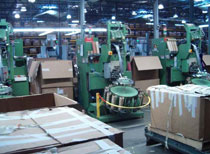 Interface’s Unique Operations
Interface’s Unique OperationsAlthough Interface’s main headquarters are located in Atlanta, Georgia, several of its plants are situate just south of the city in the smaller towns of LaGrange and West Point. There are nine primary factories worldwide, with over 11,000 employees and a cumulative 12.5 million square feet of warehouse space. As an integral part in manufacturing its flooring products, Interface is striving to achieve a zero carbon footprint from the time an Interface employee leaves for work to the final distribution point of the product — all by 2020.
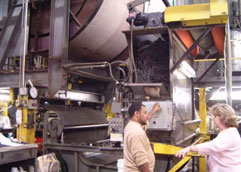 Upon entering the primary assembly plant, there is a sense of spaciousness, unlike the anticipated smells and sounds of the manufacturing process. Surprisingly lacking are noxious fumes and the roar of the typical assembly line. The workplace is clean and well organized, lit by natural light emanating through open ceiling panels. Air is circulated by large ceiling fans. The workers, or “associates,” are surprisingly cheery, exhibiting a teamwork-like attitude, knowing that in their production of eco-friendly products, they are setting an example of how other businesses might also produce goods sustainably.
Upon entering the primary assembly plant, there is a sense of spaciousness, unlike the anticipated smells and sounds of the manufacturing process. Surprisingly lacking are noxious fumes and the roar of the typical assembly line. The workplace is clean and well organized, lit by natural light emanating through open ceiling panels. Air is circulated by large ceiling fans. The workers, or “associates,” are surprisingly cheery, exhibiting a teamwork-like attitude, knowing that in their production of eco-friendly products, they are setting an example of how other businesses might also produce goods sustainably.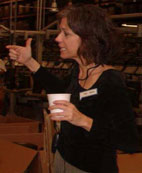 Marketing and Production
Marketing and ProductionLed into a glassed-partitioned conference room, our JVBL team was introduced to the company’s most recent innovations. One of the company’s marketers demonstrated how the tiles are now being constructed to resist curling, constriction, and contraction to remain stable in different climate zones and under different humidity conditions. The company has also recently eliminated the use of glue in both the installation of the product as well as in fusing the nylon fibers to the tile backing in the production process. This program is known as I’m Off Glue™. To demonstrate these capabilities, several tiles were positioned together, flat on a tabletop. Using a hook mounted in the middle of one of the tiles, it was virtually impossible to lift the tile vertically. This adherence was accomplished through a natural vacuum or suction.
To reduce the amount of carpet replaced in worn or high traffic areas in a customer’s workplace, random patterns are being introduced to blend easily with the remaining carpet tiles. In this manner, the tiles can be installed in any direction to produce a blended match without the need to replace the entire floor covering.
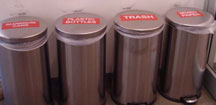 Evidence of environmental awareness is evident throughout Interface’s buildings. Even in conference areas, the associates routinely practice resource reduction, reuse, and recycling. During company meetings, no chalk or dry erase boards are used – rather, a scroll of paper is the medium of choice to illustrate ideas. Once the scroll is completely used, it is reversed, used again, and ultimately recycled. Plastic water bottles have been replaced by plant-based containers. All refuse accumulated in the course of a workday is segregated for recycling.
Evidence of environmental awareness is evident throughout Interface’s buildings. Even in conference areas, the associates routinely practice resource reduction, reuse, and recycling. During company meetings, no chalk or dry erase boards are used – rather, a scroll of paper is the medium of choice to illustrate ideas. Once the scroll is completely used, it is reversed, used again, and ultimately recycled. Plastic water bottles have been replaced by plant-based containers. All refuse accumulated in the course of a workday is segregated for recycling.Due to its commitment to zero waste, and considering its power and position of influence in the global marketplace, Interface can select its suppliers, vendors, and distributors according to their commitment to shared environmental objectives. For example, the shiny substance covering the back of each tile is no longer coated with a polymer-based plastic but has been substituted for a product, referred to as polylactide or “PLA” — a biodegradable polymer — which is essentially a corn-based product made by Cargill. This product has the diaphanous and durability characteristics of plastic without its detrimental environmental consequences. Even everyday transportation is part of the sustainability equation. The company vehicle is a Subaru™ – another company committed to zero waste and landfill. Area restaurants and caterers know that their services will not be needed by Interface without their firm commitment to discontinuing the use of Styrofoam – a non-biodegradable substance often used in the production of disposable containers and cups.
 When the company faces a new challenge or desires to ameliorate a certain deleterious practice, members of the Interface research and development team turn to nature, employing the practice of “biomimicry.” When extra adhesion was needed to anchor adjoining corners of tiles, studies were made using relevant plants, animals, and processes found in nature. The company, after studying the adherence characteristics of the spider, the fly, and the gecko, created a similar substance from natural elements to produce a TacTile™. The TacTile™ is a 4” x 4” clear sheet of PLA lined on one side with the biologically-duplicated adhering substance. Resembling a clear Post-It™ note, the individual sheet is then positioned beneath the adjoining corners to create a firm hold with a side-pull adhesion quality. Tiles cannot be pulled apart, but can be lifted on the corners to be replaced.
When the company faces a new challenge or desires to ameliorate a certain deleterious practice, members of the Interface research and development team turn to nature, employing the practice of “biomimicry.” When extra adhesion was needed to anchor adjoining corners of tiles, studies were made using relevant plants, animals, and processes found in nature. The company, after studying the adherence characteristics of the spider, the fly, and the gecko, created a similar substance from natural elements to produce a TacTile™. The TacTile™ is a 4” x 4” clear sheet of PLA lined on one side with the biologically-duplicated adhering substance. Resembling a clear Post-It™ note, the individual sheet is then positioned beneath the adjoining corners to create a firm hold with a side-pull adhesion quality. Tiles cannot be pulled apart, but can be lifted on the corners to be replaced.Tied into the initial demonstration and marketing area is the production floor. No protective equipment was necessary to enter and explore and no parts of the assembly line floor were “off limits.” The workers were very friendly and willing to explain their respective duties with enthusiasm and pride when queried. None of the forklifts used by the workers in the production area were fueled by diesel or gas; rather, they operated on batteries which are continuously re-charged.
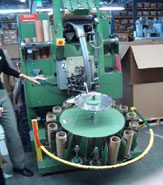 During the early years of Interface, production methods employed the use of over 1000 needles, with individual threads flowing through each, often tangling or breaking before the fibers were fully tufted to complete the product. In cases where individual threads became tangled, or a needle snapped, or a fiber broke, or a new pattern began, the partial product or accumulation of waste materials would usually be discarded in a nearby landfill. Now, the flow of fibers is guided by individual flexible tubes to reduce entanglement and breaks. This practice withdrew a significant portion of the over 5 billion pounds of carpet scrap dumped in U.S. landfills annually.
During the early years of Interface, production methods employed the use of over 1000 needles, with individual threads flowing through each, often tangling or breaking before the fibers were fully tufted to complete the product. In cases where individual threads became tangled, or a needle snapped, or a fiber broke, or a new pattern began, the partial product or accumulation of waste materials would usually be discarded in a nearby landfill. Now, the flow of fibers is guided by individual flexible tubes to reduce entanglement and breaks. This practice withdrew a significant portion of the over 5 billion pounds of carpet scrap dumped in U.S. landfills annually.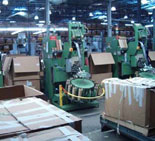 Now broken threads of the same color are easily fused back together. The ends are rejoined by overlapping two strands of like color by approximately ten inches, and a machine customized by Interface interjects air into the overlapped threads, causing them to intertwine. This is just one example of how all previous wasted materials are now reused to create a new floor cover product. Another sustainable practice is exemplified by the construction material of the storage modules. Supplies throughout the warehouses are stored and moved around to different parts of the plant in cardboard boxes which are repeatedly used until the point of disintegration. Even the masking tape used to bind the boxes is made locally from biodegradable materials.
Now broken threads of the same color are easily fused back together. The ends are rejoined by overlapping two strands of like color by approximately ten inches, and a machine customized by Interface interjects air into the overlapped threads, causing them to intertwine. This is just one example of how all previous wasted materials are now reused to create a new floor cover product. Another sustainable practice is exemplified by the construction material of the storage modules. Supplies throughout the warehouses are stored and moved around to different parts of the plant in cardboard boxes which are repeatedly used until the point of disintegration. Even the masking tape used to bind the boxes is made locally from biodegradable materials.Sales and Distribution
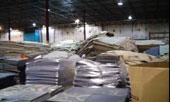 Following the initial tour of the factory floor, a brief meeting was held in the local headquarters and the tour continued to an adjoining warehouse where Interface’s new program, ReEntry™ had been recently launched. In addition to eliminating waste in the production process, the ReEntry™ program recycles used flooring covers – originally manufactured by Interface as well as by other carpet makers. Drivers haul in used carpeting that would otherwise be dumped in landfills. It is cheaper for the drivers to unload these unwanted products in this manner. While the main intake center is located in LaGrange, Georgia, Interface is in the process of locating additional sites throughout the country to reduce the distance to haul and deliver used carpeting. The company ultimately wants to establish regional reception centers — all within 100 miles of each other — and to employ local workers at those new facilities.
Following the initial tour of the factory floor, a brief meeting was held in the local headquarters and the tour continued to an adjoining warehouse where Interface’s new program, ReEntry™ had been recently launched. In addition to eliminating waste in the production process, the ReEntry™ program recycles used flooring covers – originally manufactured by Interface as well as by other carpet makers. Drivers haul in used carpeting that would otherwise be dumped in landfills. It is cheaper for the drivers to unload these unwanted products in this manner. While the main intake center is located in LaGrange, Georgia, Interface is in the process of locating additional sites throughout the country to reduce the distance to haul and deliver used carpeting. The company ultimately wants to establish regional reception centers — all within 100 miles of each other — and to employ local workers at those new facilities.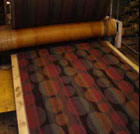 Multiple programs and products are currently in place or under development. The Evergreen Lease® program is a way for institutions — e.g., schools, nursing homes, hospitals, airports, hotels, libraries, convention centers — to install carpeting without purchasing, installing, maintaining, and ultimately discarding the product. With the leasing arrangement, Interface supplies the carpet, keeps it clean, and removes it when the lessor decides to remodel or raze the premises. This program presents a win-win situation: the lessor saves resources and time by having the work done by the manufacturer and Interface can insure that the final discarded product is properly recycled.
Multiple programs and products are currently in place or under development. The Evergreen Lease® program is a way for institutions — e.g., schools, nursing homes, hospitals, airports, hotels, libraries, convention centers — to install carpeting without purchasing, installing, maintaining, and ultimately discarding the product. With the leasing arrangement, Interface supplies the carpet, keeps it clean, and removes it when the lessor decides to remodel or raze the premises. This program presents a win-win situation: the lessor saves resources and time by having the work done by the manufacturer and Interface can insure that the final discarded product is properly recycled.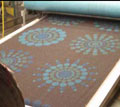 New products are being manufactured under the Bentley Prince Street™ line which blends aesthetics with ecological responsibility. Modular carpet tiles are produced under the InterfaceFLOR™ lines (Americas, Europe, Asia) which provide a plethora of designs in the workplace while remaining true to the company’s Zero Mission.™
New products are being manufactured under the Bentley Prince Street™ line which blends aesthetics with ecological responsibility. Modular carpet tiles are produced under the InterfaceFLOR™ lines (Americas, Europe, Asia) which provide a plethora of designs in the workplace while remaining true to the company’s Zero Mission.™Research and Development
Simply stated, members of Interface’s Research and Development team are driven by one principle: merge brain power with common sense. While government regulations are not spurned in the creation of new products and processes, tax credits for new, cleaner, and ecologically sustainable products and offsetting practices are preferred. Interface’s R & D Department is characterized by numerous professions, ranging from the nannomicrobiologist to the mechanical engineer. Several R & D associates have even come up through the ranks without any specialized degrees or training and have proven themselves to be invaluable team members.
ReEntry™, Recycling and Renewal
Re-Entry™ is currently run as a separate entity. The program receives all used carpeting – tiles and broadloom. Carpet dealers can dispose the used articles at Interface without incurring a higher landfill cost. These independent dealers do bear the cost of transportation and Interface is currently striving to open additional warehouses nationwide to serve as central drop off locations.
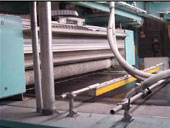 Before the used goods are broken down and reprocessed, those samples deemed to be in substantially good shape are donated to non-profit organizations. Multi-million dollar, customized machines, then begin the process of segregating the different layers of the carpet remnant. Nothing is wasted throughout the process. Since this carpeting has been discarded primarily due to wear and tear and the consequences of high traffic over time, the accumulated dirt is shaken loose. Interface even has a market for the collection and reuse of the accumulated dirt.
Before the used goods are broken down and reprocessed, those samples deemed to be in substantially good shape are donated to non-profit organizations. Multi-million dollar, customized machines, then begin the process of segregating the different layers of the carpet remnant. Nothing is wasted throughout the process. Since this carpeting has been discarded primarily due to wear and tear and the consequences of high traffic over time, the accumulated dirt is shaken loose. Interface even has a market for the collection and reuse of the accumulated dirt.Next, the top fibers are sheered, separated, and formed into new threads. All polymer-based nylon fibers are extracted from the backing which end product is then used at other businesses to produce such parts as vehicle dashboards. The residue is shaped into small, round balls or crumbs, known as “Cool Blue Food™” — harmless to the human system as the new substance lacks toxins, metals, and nonorganic flame retardants.
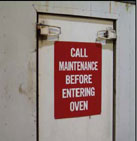 The crumbs are then sent to an adjoining plant to be further purified and cleaned. During the process of merging the backing with the new fibers, the layers must be melted together carefully in an “oven” which generates a precise temperature of 320 degrees both above and below the layers of pellets to form the new product. The energy used to generate this heat is derived from methane gas captured from a local landfill. When queried as to how this type of energy was selected, when the plant opened, local city officials originally wanted to charge Interface approximately one million dollars to install the necessary piping to connect the factory to the landfill. Interface, in response, inquired as to the charges that would be incurred by the utility company in installing and connecting electrical lines to the business. The point was made and the methane gas recapture produced a favorable outcome for both entities. This process of using captured methane gas earned Interface the EPA Energy Award in 2006.
The crumbs are then sent to an adjoining plant to be further purified and cleaned. During the process of merging the backing with the new fibers, the layers must be melted together carefully in an “oven” which generates a precise temperature of 320 degrees both above and below the layers of pellets to form the new product. The energy used to generate this heat is derived from methane gas captured from a local landfill. When queried as to how this type of energy was selected, when the plant opened, local city officials originally wanted to charge Interface approximately one million dollars to install the necessary piping to connect the factory to the landfill. Interface, in response, inquired as to the charges that would be incurred by the utility company in installing and connecting electrical lines to the business. The point was made and the methane gas recapture produced a favorable outcome for both entities. This process of using captured methane gas earned Interface the EPA Energy Award in 2006.Interface has dedicated a substantial amount of time and financial resources to make its operations sustainable. Approximately 20 R & D associates, working over a 7-year period of time, have surprisingly generated a high return on investment (ROI). The ROI achieved is $4.40 for each dollar spent. Additionally, Interface maintains an aggressive patent program to protect its proprietary technology which is a major factor in creating competitive advantage. Interface believes that demonstrating a superior business model in a competitive marketplace is the key to influencing companies in much larger industries than carpets. Through such influence, Interface believes it will become restorative — not by just what it does in its own operations to reduce impact, but also by what it influences others to do. It is quite likely that Interface is already restorative (by this definition) even though it would not claim to be sustainable…yet.
Members of the R & D crew are encouraged to study other matters to help repair the biosphere while making sustainable, useful products for Interface customers. This diversity in purpose allows for greater versatility. Currently, several team members are investigating the different ways of producing algae-based fuel for widespread use as a clean energy source alternative.
In addition to its R & D members, Interface employs the services of a designer, known for his commitment to fashioning items which eliminate material waste yet exude a high degree of aesthetics and creativity. This designer lives in LaGrange, in the middle of the Georgia pines, in close proximity to Interface’s main operations.
Concluding Remarks
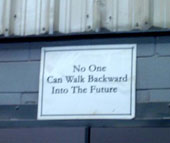 Interface is well on its way to the 2020 goal of complete sustainability and has on board vendors, suppliers, distributors, customers, and most importantly, a workforce united to achieve this milestone as a group effort. Through its worldwide operations and the insatiable dedication of its workers to pursue and promote innovation and creativity, the vision of complete sustainability is becoming a reality. It is now time
Interface is well on its way to the 2020 goal of complete sustainability and has on board vendors, suppliers, distributors, customers, and most importantly, a workforce united to achieve this milestone as a group effort. Through its worldwide operations and the insatiable dedication of its workers to pursue and promote innovation and creativity, the vision of complete sustainability is becoming a reality. It is now time
